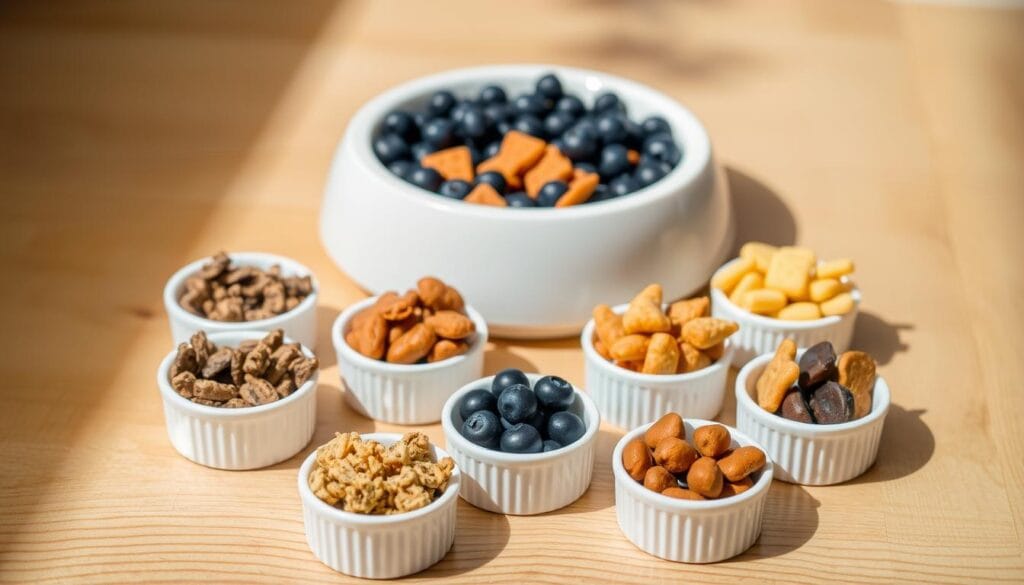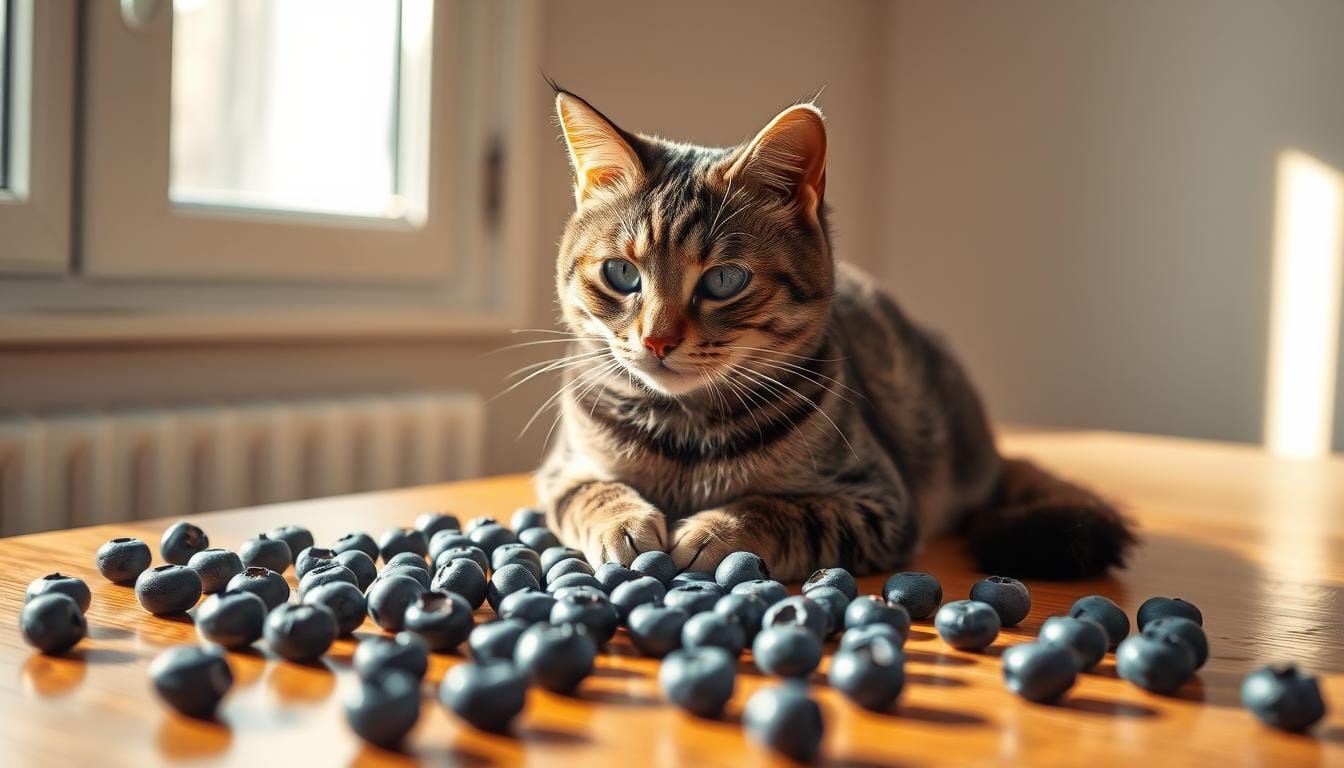Can Cats Eat Blueberries? Benefits and Risks Explained
Picture this: your curious companion paws at a bowl of fresh fruit on the kitchen counter. Those round, juicy treats might seem harmless, but as a caring pet parent, you pause. Could sharing this snack help or harm your furry family member?
Many pet owners wonder about offering human foods to their animals. While blueberries aren’t toxic to most felines, every cat’s needs differ. Factors like age, existing medical conditions, and diet play vital roles in determining what’s safe. Always consult your veterinarian before introducing new items to your pet’s meals.
Table of Contents
These antioxidant-rich berries can serve as occasional snacks when prepared properly. However, overfeeding might lead to digestive issues or weight gain. Watch for signs like vomiting or changes in appetite if you decide to offer small portions.
This guide explores the balance between potential benefits and risks. You’ll discover proper serving sizes, preparation tips, and when to avoid these fruits altogether. Your cat’s health and happiness deserve informed decisions backed by professional advice.
Introducing Blueberries as a Feline Treat
Bursting with vibrant color and nutrients, these small fruits have captured human interest for their health benefits. Their reputation as a superfood stems from a unique blend of antioxidants, vitamins, and hydration-friendly properties. While not essential for carnivorous diets, they offer intriguing possibilities as occasional snacks when handled responsibly.
What Makes Blueberries Special?
At their core, these berries pack anthocyanins – pigments responsible for their deep hue and antioxidant power. These compounds neutralize free radicals, potentially supporting cellular health. Combined with vitamin C, they create a defense system against oxidative stress in living organisms.
Nutritional Overview of Blueberries
Every 100g serving delivers essential nutrients while remaining low in calories. Here’s how wild and cultivated varieties compare:
| Nutrient | Wild Blueberries | Cultivated Blueberries |
|---|---|---|
| Antioxidants | 13,427 total* | 9,019 total* |
| Vitamin K | 24% DV | 16% DV |
| Dietary Fiber | 4.9g | 3.6g |
| Water Content | 85% | 84% |
*ORAC (Oxygen Radical Absorbance Capacity) values per 100g. Wild Nordic varieties often outperform due to harsh growing conditions that boost phytochemical production.
The high moisture content makes them hydrating treats, though they shouldn’t replace water bowls. Minerals like manganese support bone health, while vitamin A aids vision – benefits that might extend to feline companions in moderation.
Exploring the Safety of Blueberries for Cats
Felines evolved as obligate carnivores, thriving on protein-rich meals rather than plant matter. Their digestive systems prioritize breaking down animal tissues, lacking enzymes to efficiently process fibrous fruits. This biological reality explains why many pets show little interest in sweet flavors.
Unlike grapes or citrus fruits that pose severe risks, these small berries don’t contain known toxins for most animals. However, their suitability varies between individuals. Observe your companion closely during initial tastings to detect adverse reactions like lethargy or stomach discomfort.
| Safe Fruits | Unsafe Fruits | Potential Risks |
|---|---|---|
| Blueberries | Grapes/Raisins | Kidney failure |
| Bananas | Cherries | Cyanide poisoning |
| Apples (seedless) | Avocados | Persin toxicity |
Introduce new foods gradually, starting with mashed or crushed pieces. Watch for these warning signs:
- Diarrhea within 12 hours
- Excessive scratching or skin irritation
- Refusal to eat regular meals
While occasional berry snacks won’t harm healthy adults, they shouldn’t replace meat-based nutrition. Always prioritize your pet’s primary diet and consult a vet before making significant changes.
Can Cats Eat Blueberries
Offering fruits to your feline requires careful thought. While fresh or frozen options are generally safe, preparation methods and sourcing determine their suitability. Organic varieties minimize exposure to pesticides, making them a smarter choice for sensitive digestive systems.
Essential Considerations for Pet Owners
Not all berry products align with feline biology. Avoid anything sweetened or processed, including jams and baked goods containing artificial additives. These often include xylitol or excessive sugars that disrupt metabolism.
| Safe Options | Avoid These |
|---|---|
| Fresh organic berries | Blueberry pie filling |
| Plain frozen berries | Yogurt-covered snacks |
| Cat treats with blueberries | Muffins or desserts |
Commercially prepared treats designed for felines offer controlled portions with balanced nutrition. Always check labels for hidden ingredients like chocolate or caffeine, which are toxic. Mash larger berries to prevent choking hazards.
Health conditions like diabetes or kidney issues may require avoiding fruits altogether. Consult your veterinarian before introducing new foods, especially if your companion has dietary restrictions. Moderation remains key – even safe snacks shouldn’t exceed 10% of daily calories.
Assessing the Health Benefits for Your Cat
When considering treats for your feline friend, nutritional value matters. These bite-sized snacks pack a surprising punch of health benefits when served properly. Let’s explore how specific components support your pet’s well-being.

Antioxidants, Fiber, and Vitamins
Rich in anthocyanins, these berries help combat oxidative stress. This protection extends to joint tissues and immune cells, particularly beneficial for older animals. The natural compounds may slow cellular aging while supporting mobility.
| Nutrient | Benefit | Key Advantage |
|---|---|---|
| Antioxidants | Fights free radicals | Supports immune function |
| Dietary Fiber | Aids digestion | Reduces hairball formation |
| Vitamin C | Collagen production | Promotes skin health |
| Manganese | Bone development | Supports metabolism |
Fiber content helps regulate bowel movements, especially useful for pets prone to constipation. Roughage moves through the digestive tract gently, aiding nutrient absorption from primary meals.
Crushed berries provide mild abrasive action during chewing. This natural scrubbing action reduces plaque buildup on teeth. Combine this with regular dental care for optimal oral hygiene.
Low-calorie counts make these fruits ideal for weight-conscious diets. Substitute high-fat treats with 2-3 berries weekly to maintain lean body mass. Always monitor your companion’s reaction when introducing new foods.
Understanding the Potential Risks
While those tiny fruits seem harmless at first glance, hidden challenges lurk beneath their juicy surface. Feline biology wasn’t designed for plant-based snacks, creating unique vulnerabilities even with non-toxic foods.
Sweet Peril and Stomach Sensitivities
These berries contain natural sugars that can spike blood glucose levels. Though pets don’t taste sweetness like humans, their bodies still process these compounds. For diabetic companions, even small amounts might trigger dangerous fluctuations requiring medical intervention.
| Risk Factor | Healthy Pets | Diabetic Pets |
|---|---|---|
| Blood Sugar Impact | Mild increase | Severe instability |
| Digestive Tolerance | Possible discomfort | Higher complication risk |
| Safe Frequency | 1-2 weekly | Not recommended |
Gastrointestinal issues rank among the most common reactions. Sensitive stomachs may rebel against unfamiliar fibers, leading to vomiting or diarrhea. Start with pea-sized portions to test tolerance.
Carbohydrate content poses another challenge. Obligate carnivores struggle to break down plant-based nutrients efficiently. Overconsumption displaces essential proteins from their diet, potentially causing nutritional gaps over time.
Watch for these warning signs after introducing new snacks:
- Lethargy lasting more than 12 hours
- Changes in litter box habits
- Unusual scratching or skin redness
Figuring Out Appropriate Serving Sizes
Portion control separates harmless snacking from potential health hazards. Veterinarians recommend limiting all treats – including fruits – to 10% of daily calories. For an average 10-pound feline, this equals about 20 calories from extras beyond their main meals.

Start with a single berry to test tolerance. Wait 24 hours before offering more. If no digestive issues appear, gradually increase to two or three pieces weekly. Overfeeding may lead to diarrhea or weight gain, even with healthy options.
| Cat Weight | Max Weekly Servings | Portion Size |
|---|---|---|
| Under 8 lbs | 1-2 | 1 berry |
| 8-12 lbs | 2-3 | 2 berries |
| Over 12 lbs | 3 | 3 berries |
Senior pets or those with diabetes often need stricter limits. Consult your vet before introducing new foods if your companion has medical conditions. Always crush or slice berries to prevent choking.
Treats should complement – not replace – meat-based nutrition. Track all snacks given throughout the day to avoid exceeding safe quantities. Remember: small amounts keep these fruity extras enjoyable without risking health.
How to Prepare Blueberries for Your Cat
Proper preparation transforms fresh berries into safe, enjoyable snacks. Follow these steps to minimize risks while maximizing nutritional value for your furry friend.
Essential Cleaning and Preparation Steps
Begin by rinsing berries under cool running water for 10 seconds. This removes surface dirt and reduces pesticide residues by up to 80%, according to USDA studies. Pat dry with a clean towel to prevent bacterial growth.
| Proper Technique | Common Mistakes | Safety Benefit |
|---|---|---|
| Washing before cutting | Skipping rinsing | Reduces contaminants |
| Removing stems | Serving whole berries | Prevents choking |
| Mashing thoroughly | Using frozen varieties | Protects teeth |
Inspect each berry for leaves or debris. Use your thumb to roll off stubborn stems. For small pets, slice berries into quarters or create a smooth puree using a fork. This texture mixes easily with regular food.
Avoid frozen options entirely – their hardness can crack delicate teeth. Prepared portions stay fresh in airtight containers for 48 hours. Discard uneaten mashed berries after two hours to prevent spoilage.
Mix small amounts into your companion’s meals twice weekly. Observe eating habits closely during initial feedings. Discontinue use if you notice digestive changes or disinterest in regular foods.
Incorporating Blueberries in a Balanced Diet
Balancing your pet’s snack choices with their biological needs requires precision. Felines thrive on meat-based diets as obligate carnivores, needing animal proteins for survival. Plant-based foods like fruits should never displace core nutritional sources.
Aligning Treats with Carnivorous Needs
Treats work best when they complement – not compete with – essential nutrients from meat. Offer berries sparingly: 1-2 pieces weekly keeps curiosity satisfied without disrupting meals. Crush them into existing food to maintain interest in primary protein sources.
Watch for reduced appetite after snack time. If your companion walks away from their regular cat diet, scale back fruity extras immediately. Their digestive systems prioritize processing animal tissues over plant matter.
Always prioritize veterinary guidance when adjusting meal plans. Remember: occasional treats enhance bonding moments but shouldn’t redefine nutritional priorities. Keep meat at the center of every feeding routine to honor their evolutionary design as carnivores.
- Can Cats Eat Pineapple? Safety Tips for Cat Owners
- Can Cats Eat Mango? What Every Cat Owner Should Know
- Can Cats Eat Grapes? Vet Answers and Safe Alternatives
- Can cats eat chicken and what are the health benefits?
- Can cats have chicken as a protein source? Comprehensive guide
- Can Cats Eat Raw Chicken? Safety Guide for Cat Owners
- Dry Cat Food Brands Loved by Cats and Trusted by Vets
- Best Cat Food for Sensitive Stomach:Top 5 Vet-Approved Picks
- Special Kitty Kitten Food – Learn the Pros and Cons
- prescription cat food-Top 10 Prescription Cat Foods
- Wet Cat Food for Kittens: Top Nutritious Choices 2025
- How Long Can Wet Cat Food Sit Out? Critical Facts
- American Veterinary Medical Association (AVMA)

